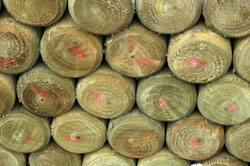 If you’re building garden beds, or anything outdoors, using wood can be challenging as nature and the seasons can rot, dry and damage untreated wood very rapidly. Treated wood, mainly pine, has been around for decades now, and there has been a lot of concern about how safe it is for our gardens, kids and pets. The most common treated timber still used in Australia is ‘treated’ with copper chrome arsenate (CCA), despite being made illegal to use anywhere where people may come into frequent contact with it. So that rules out gardens, garden furniture, picnic tables, exterior seating, kid’s play equipment, patios, decking and handrails. What is strange is that structures built from it before 2006 don’t have to be replaced. Hmm, why not, if it was made illegal after 2006?
If you’re building garden beds, or anything outdoors, using wood can be challenging as nature and the seasons can rot, dry and damage untreated wood very rapidly. Treated wood, mainly pine, has been around for decades now, and there has been a lot of concern about how safe it is for our gardens, kids and pets. The most common treated timber still used in Australia is ‘treated’ with copper chrome arsenate (CCA), despite being made illegal to use anywhere where people may come into frequent contact with it. So that rules out gardens, garden furniture, picnic tables, exterior seating, kid’s play equipment, patios, decking and handrails. What is strange is that structures built from it before 2006 don’t have to be replaced. Hmm, why not, if it was made illegal after 2006?
CCA timber resists fungi, termites and takes a long time to decay. The CSIRO reports that potential ingestion rates from CCA-treated timber around garden beds is well within tolerable limits, but is it worth the risk to your health, and do you really want any amount of CCA in your body? Arsenic does occur naturally in Australian soils and is the 20th most common element on Earth.
What are the alternatives?
The two most common treated timber alternatives now available are alkaline copper quaternary (ACQ) and copper azole (CA). They are both, however, mosr expensive than CCA and leach copper in the soil. And like CCA, neither can be burnt safely. To date, the true health risks from copper-based treated timbers is not clear.
The main reason people choose treated timber for garden beds is its durability, but there are many other durable options available, most of which have been used by gardeners long before treated timber came along. These include:
- Bricks, stones, concrete blocks, pavers (these hold beneficial heat from sun in winter also)
- Straw bales
- Old rainwater tanks cut to size
- There are now many recycled plastic (food grade, UV treated) garden bed options on the market
- For strictly organic gardens, avoid all treated timbers, plastics, recycled materials, non-natural materials – instead, look for certified organic options
- Old untreated logs and railway sleepers can be used, but will eventually decay faster than treated timber or plastic options. However, you will get a good lifespan from large logs/sleepers if they are thick enough
- Also consider designing your garden along or around natural aspects of your landscape – ponds, walls, retaining walls, drains, fences and other borders
